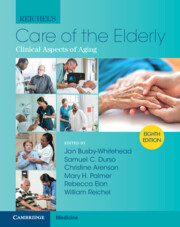Book contents
- Reichel’s Care of the Elderly
- Reichel’s Care of the Elderly
- Copyright page
- In Memoriam
- Contents
- Contributors
- Section I General Approach to the Care of the Elderly
- Section II Geriatric Syndromes
- Section III Care of the Elderly by Organ System
- Chapter 13 Diagnosis and Management of Heart Disease
- Chapter 14 Hypertension
- Chapter 15 Peripheral Artery Disease
- Chapter 16 Neurologic Problems
- Chapter 17 Prevention, Diagnosis, and Management of Stroke
- Chapter 18 Movement Disorders
- Chapter 19 Sleep Disorders
- Chapter 20 Clinical Geropsychiatry
- Chapter 21 Substance Use Disorder
- Chapter 22 Pulmonary Issues
- Chapter 23 Gastrointestinal Disorders
- Chapter 24 Serious Infections
- Chapter 25 Human Immunodeficiency Virus
- Chapter 26 Kidney Disease
- Chapter 27 Urological Conditions
- Chapter 28 Urinary Incontinence
- Chapter 29 Fecal Incontinence
- Chapter 30 Gynecologic Issues
- Chapter 31 Endocrine Disorders
- Chapter 32 Diabetes Mellitus
- Chapter 33 Lipid Management
- Chapter 34 Osteoporosis and Other Metabolic Bone Disorders
- Chapter 35 Common Rheumatologic Disease
- Chapter 36 Geriatric Emergency Medicine
- Chapter 37 Musculoskeletal Injuries
- Chapter 38 Dermatologic Conditions
- Chapter 39 Pressure Injuries
- Chapter 40 Anemia and Other Hematological Problems
- Chapter 41 Cancer
- Chapter 42 Ocular Disorders
- Chapter 43 Geriatric Otolaryngology
- Chapter 44 Oral Health
- Chapter 45 Foot Health
- Section IV Principles of Care for the Elderly
- Index
- Plate Section (PDF Only)
- References
Chapter 24 - Serious Infections
from Section III - Care of the Elderly by Organ System
Published online by Cambridge University Press: 30 June 2022
- Reichel’s Care of the Elderly
- Reichel’s Care of the Elderly
- Copyright page
- In Memoriam
- Contents
- Contributors
- Section I General Approach to the Care of the Elderly
- Section II Geriatric Syndromes
- Section III Care of the Elderly by Organ System
- Chapter 13 Diagnosis and Management of Heart Disease
- Chapter 14 Hypertension
- Chapter 15 Peripheral Artery Disease
- Chapter 16 Neurologic Problems
- Chapter 17 Prevention, Diagnosis, and Management of Stroke
- Chapter 18 Movement Disorders
- Chapter 19 Sleep Disorders
- Chapter 20 Clinical Geropsychiatry
- Chapter 21 Substance Use Disorder
- Chapter 22 Pulmonary Issues
- Chapter 23 Gastrointestinal Disorders
- Chapter 24 Serious Infections
- Chapter 25 Human Immunodeficiency Virus
- Chapter 26 Kidney Disease
- Chapter 27 Urological Conditions
- Chapter 28 Urinary Incontinence
- Chapter 29 Fecal Incontinence
- Chapter 30 Gynecologic Issues
- Chapter 31 Endocrine Disorders
- Chapter 32 Diabetes Mellitus
- Chapter 33 Lipid Management
- Chapter 34 Osteoporosis and Other Metabolic Bone Disorders
- Chapter 35 Common Rheumatologic Disease
- Chapter 36 Geriatric Emergency Medicine
- Chapter 37 Musculoskeletal Injuries
- Chapter 38 Dermatologic Conditions
- Chapter 39 Pressure Injuries
- Chapter 40 Anemia and Other Hematological Problems
- Chapter 41 Cancer
- Chapter 42 Ocular Disorders
- Chapter 43 Geriatric Otolaryngology
- Chapter 44 Oral Health
- Chapter 45 Foot Health
- Section IV Principles of Care for the Elderly
- Index
- Plate Section (PDF Only)
- References
Summary
As the population in the United States continues to age, familiarity with the clinical presentation, diagnosis, and management of the major serious infections of elderly individuals becomes an increasingly critical component of general medicine and primary care. While modern medicine has significantly reduced early death due to infection, diseases caused by infectious pathogens remain a major cause of illness and death among elderly persons. This chapter reviews the immunology of the elder host and environmental factors that make older adults uniquely vulnerable to infectious diseases. We propose an approach to the elderly patient with suspected infectious disease and highlight the differences in clinical presentation among older and younger patients, as well as addressing diagnosis and management of common and serious infectious diseases of older adults including urinary tract infection, bacterial pneumonia, influenza, herpes zoster, and Clostridioides difficile.
- Type
- Chapter
- Information
- Reichel's Care of the ElderlyClinical Aspects of Aging, pp. 297 - 309Publisher: Cambridge University PressPrint publication year: 2022

